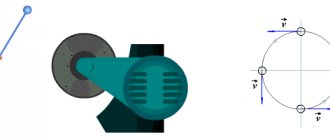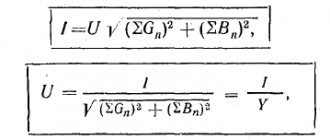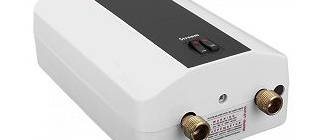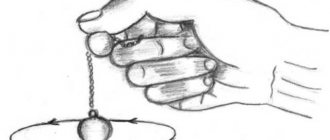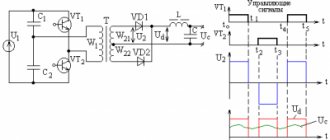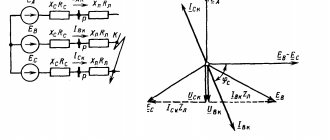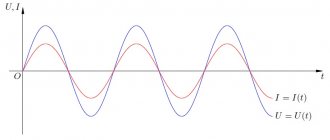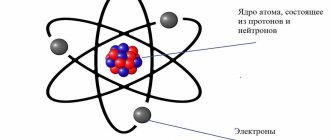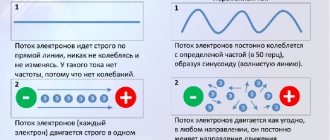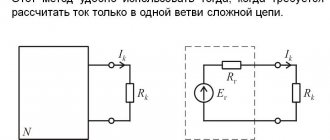High frequency currents
High frequency currents (HFC) are considered to be currents for which the quasi-stationary condition is not satisfied, resulting in a strongly pronounced skin effect.
For this reason, current flows along the surface of the conductor without penetrating into its volume. the frequency of such currents exceeds 10,000 Hz. To obtain currents with a frequency of more than several tens of kilohertz, electric machine generators are used, which include a stator and a rotor. On their surfaces facing each other there are teeth, due to the mutual movement of which a pulsation of the magnetic field occurs. The final frequency of the current received at the output is equal to the product of the rotor speed and the number of teeth on it.
Also, to obtain HDTV, oscillatory circuits are used, for example, an electrical circuit, which contains inductance and capacitance. To obtain high-frequency frequencies of billions of hertz, installations with a hollow oscillatory circuit (BWO, TWT, magnetron, klystron) are used.
If a conductor is placed in the magnetic field of a coil in which a high-frequency current flows, then large eddy currents will arise in the conductor, which will heat it. The temperature and intensity of heating can be adjusted by changing the current in the coils. Thanks to this property, HDTV is used in many areas of human activity: in induction furnaces, in metallurgy for surface hardening of parts, medicine, agriculture, in household appliances (microwave ovens, various cooking devices), radio communications, radar, television, etc.
Examples of using high frequency currents
Using HDTV in induction furnaces you can melt any metals. The advantage of this type of smelting is the possibility of smelting under conditions of complete vacuum, when contact with the atmosphere is excluded. This makes it possible to produce alloys that are pure in non-metallic inclusions and unsaturated with gases (hydrogen, nitrogen).
On hardening machines using high-frequency frequencies it is possible to harden steel products only in the surface layer due to the skin effect. This makes it possible to obtain parts with a hard surface that can resist significant loads and at the same time without reducing wear resistance and ductility, since the core remains soft.
In medicine, high-frequency currents have long been used in UHF devices, where heating of a dielectric is used to warm up any human organs. HDTV, even of very high current strength, is harmless to humans, since it flows exclusively in the most superficial layers of the skin. Also in medicine, electric knives based on high-frequency frequency are used, with the help of which they “seal” blood vessels and cut tissues.
HDTV installations
HDTV installations are considered the most suitable for use in mass production; hardening with their help allows you to achieve the most effective results.
The impact of this type of installation significantly increases the level of mechanical strength of parts against abrasion and friction. Heat treatment of the surfaces of parts begins with the fact that the heated part must be placed in an electromagnetic field, which is located inside a copper tube bent along the contour of the part to be hardened, while high-frequency alternating currents are pushed away by the alternating magnetic current generated from within to the surface of the part. The high rate of heating of the surface of the part is explained by the high density of induced currents on it. A high level of hardness of the hardened metal layer and depth are two main characteristics of induction hardening with high frequency currents. The advantages of this type of heat treatment include high productivity, high hardness, absence of scale, the ability to select the level of hardening depth, and the ability to process metal parts of any shape.
It is thanks to this list of advantages that high-frequency hardening has established itself as a highly productive and economical method of heat treatment of the surface of parts, which ensures excellent quality of processed products and the highest strength. It should also be noted that in modern production welding with high frequency current is widely used. The energy consumption spent on welding and the quality of welded joints are determined by the specific features of the process of high-frequency currents flowing through the conductor.
Physiotherapy DDT: indications, contraindications, effect on the body
The first to propose this method of treatment was a French doctor named Bernard. Subsequently, these currents were called “Bernard currents” and today are widely used in medicine.
This scientist proved the effectiveness of the combined use of half-sinusoidal pulse currents with a frequency of 50 and 100 pulses per minute.
When the epidermal layer offers great resistance, the action of diadynamic currents begins, which pass through the excitation of the exeroceptors, thus causing a burning sensation under the sensors.
This method leads to activation of peripheral blood circulation, has an analgesic effect, and also helps to optimize metabolism. When diadynamic currents move, a contraction of skeletal and smooth muscles is observed, thereby causing irritability of the muscles of the internal organs, as well as the vascular walls.
The analgesic effect is expressed in irritation of nerve receptors with a voltage of 100 Hz, thus, previously pain impulses are inhibited during the treatment. Also electric current with a frequency of 100 Hz.
cause an inhibitory effect on the sympathetic nervous system, because of this, the arterioles begin to enlarge and blood circulation and nutrition of human tissues noticeably improve. Current voltage 50 Hz. enhances lymph circulation, as well as blood circulation due to uniform contraction of muscle fibers.
A decrease in pain sensitivity is determined by the continuous repetition of impulses from peripheral receptors that were excited by electric current and, thereby, the cessation of pain occurs.
Indications for using the method may include the following violations:
• Neuritis, myalgia • Disorders of the musculoskeletal system, for example, osteochondrosis, arthrosis, arthritis, bursitis, polyarthritis and others • Bruises, fractures (without metal elements), dislocations, sprains and other injuries • Gastritis, ulcers, gallbladder dyskinesia and tracts, atony of the bladder and other pathologies associated with the digestive system• Periodontal disease• Bronchitis and asthma• Cardiac pathologies, such as cardiovascular neuroses, hypertension.
Contraindications to the use of the method may lead to negative consequences. Among the common contraindications:
• Tendency to bleeding• Individual intolerance to components• Presence of various neoplasms• Allergy to medications present during treatment with diadynamic currents• Inflammatory processes in the acute phase• Tuberculosis• Epilepsy• Exacerbation of mental state• Impaired sensitivity• Thrombophlebitis
Also, treatment with diadynamic currents cannot be carried out in the presence of damaged integumentary tissues (wounds, abrasions, etc.), but the electrodes can be slightly moved. It is also prohibited to use the method if the patient has purulent skin diseases or metal implants in the body.
It is possible to conduct a session at home if you have a device, but in this case you should not only unconditionally follow all the rules for performing the procedure, but also be sure to inform your doctor about any changes and reactions of the body.
You can undergo treatment using the DDT method at the Center for Restorative Medicine in Naberezhnye Chelny. The cost of one session is 200 rubles.
Details can be found on the website or by calling +7(953)482-66-62.
powered by
Skin effect
Definition 2
Direct current is distributed evenly across the cross-section of the conductor. With alternating current, due to the inductive interaction of different current elements, the current density is redistributed over the cross section of the conductor. The phenomenon in which the current is predominantly concentrated in the surface layer of the conductor is called skin effect .
Finished works on a similar topic
Course work: High-frequency currents. Skin effect 430 ₽ Abstract High-frequency currents. Skin effect 250 ₽ Test work High-frequency currents. Skin effect 190 ₽
Receive completed work or specialist advice on your educational project Find out the cost
Let us have a cylindrical conductor through which current flows. A magnetic field is formed around a conductor carrying current. The lines of force of this field are concentric circles, the center of which lies on the axis of the conductor. If the current strength is increased, the magnetic field induction will increase, but the shape of the field lines will not change. Accordingly, the derivative $\frac{\partial \overrightarrow{B}}{\partial t}$ is directed tangentially to the magnetic field induction line, the derivative lines are also circles that coincide with the lines of force. We know from the law of electromagnetic induction that:
The vector of the induction field strength in areas located closer to the axis of the conductor has the direction opposite to the vector of the electric field strength that creates the current; in distant areas the directions of these vectors coincide. As a result, the current density decreases near the axis and increases closer to the surface of the conductor, that is, a skin effect appears.
In metals, due to their high conductivity, the displacement current can be neglected in comparison with the conduction current. Because of this, the penetration of a magnetic field into a metal is similar to the diffusion process in mathematical terms. Let's take equation (1) and equation (2) as a basis:
We use Ohm's law:
Let's equate the right-hand sides of expressions (2) and (3) and differentiate the resulting expression, as a result we have:
Or given formula (1):
We use known relations:
we finally get:
If the current flows through a homogeneous infinite conductor, which occupies the half-space y$>$0 along the X axis, and the surface of the conductor is flat, we can write:
In this case, equation (7) is transformed to the form:
It can be assumed, that:
Substituting expression (11) into equation (10) we obtain:
The solution to equation (12) is the function:
where $\alpha =\sqrt{\frac{\omega \sigma {\mu }_0\mu }{2}}$. Let's take the real part of expression (13) and move on to the current density, using Ohm's law, we get:
If we assume that the current density amplitude $j_0=j_x\left(0,0\right)$, then expression (14) will take the form:
When every percentage counts
Despite significant progress in the field of current rectification, equipment for converting alternating current into direct current and vice versa still costs a lot of money. So large that the construction of AC networks, even taking into account the increased consumption of material for wires, is much cheaper. Regardless of the length of the line, the starting price of a high-voltage DC line necessarily includes the cost of two converters at the beginning and end of the line - large and very expensive devices produced by only a few companies in the world, including Toshiba. This equipment accounts for up to half the cost of the network.
But as the length of the line increases, the cost of an AC line increases faster than that of a DC line. This is due to the complexity of the HVAC line - to transmit the same power to HVDC, you need half as many conductors of smaller diameter, which means half as many supports, which themselves cost a lot and require extremely expensive installation. With a line length of about 600 km, the cost of HVDC and HVAC is equal, but over long distances, about 2000 km, HVDC is much cheaper than HVAC, by about 30-40%, and this is hundreds of millions of dollars in savings.
HVDC and HVAC costs intersect on a line about 600 km long. Further, HVDC becomes noticeably more profitable. Source: wdwd/Wikimedia Commons
For every 1000 km of line, losses in HVDC are 2-3%, and the most modern equipment can reduce this parameter to 1%. HVAC losses can be as high as 6%. Even in the most efficient AC networks with the best equipment, losses will be 30-40% greater than in HVDC. A few percent of total power seems to be tolerable nonsense? When it comes to networks transmitting several gigawatts, each percent turns into dozens of wasted megawatts that could be used to power a small city. Not to mention lost profits.
Electrotherapy: types and indications
Home → Useful information → Electrotherapy: types and indications
There is information according to which even ancient people used the electric field for medicinal purposes. They were used to treat paralysis, nervous and rheumatic diseases.
They received electrical discharges from amber, electric fish and other creatures.
In the second half of the 18th century, the galvanic element was invented and the widespread use of electrotherapy in medicine began, which was improved every year, based on the principles of the physiology of the human body and the laws of electromagnetic fields.
Electrotherapy is a currently widely used type of physiotherapeutic treatment that involves influencing organs and tissues through an electromagnetic field or electric current. This procedure is effective in combating various pathologies and is both a primary and an additional method of therapy.
| Injurymap Flickr |
Therapeutic effects of electrotherapy procedures:
- local, covering a specific affected area;
- reflex-segmental - through electric current, somatovegetative reflexes are evoked that regulate the activity of internal organs, blood vessels, glands, smooth muscles;
- a general effect that improves the processes of recovery and regeneration with the mobilization of vitality and strengthening of the immune system.
Classification of electrotherapy methods:
- By mode of exposure: constant and alternating pulse currents.
- By voltage value: currents with high and low frequencies.
- By the nature of energy: contact procedures and remote ones.
Types of electrotherapy procedures
Physiotherapeutic methods of electrotherapy include over a dozen different procedures based on the action of electric and electromagnetic fields on the cells and tissues of the body.
Summary
- Damage to the body depends on the strength of the electric current. Higher voltage allows higher and more dangerous currents to be created. Resistance opposes current flow, so high resistance is a good defense against electrical shocks.
- Any voltage above 30 volts is generally considered capable of producing dangerous electrical shock currents.
- When working on electrical circuits, you should definitely avoid wearing metal jewelry. Rings, watch bands, necklaces, bracelets and other similar jewelry make excellent electrical contact with your body and can themselves conduct enough current to cause skin burns even at low voltages.
- Low voltage can still be dangerous, even if it is too low to directly cause electric shock. It may be enough to frighten the victim, causing her to flinch and touch something more dangerous in close proximity.
- When it is necessary to work on a live (live) circuit, it is best to do the work with one hand to prevent the possibility of creating a dangerous hand-to-hand (chest) path for electrical current.
Original article:
- Ohm's Law (again!)

